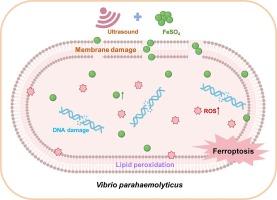超声波与硫酸亚铁结合有助于副溶血性弧菌发生铁变态反应
IF 8.7
1区 化学
Q1 ACOUSTICS
引用次数: 0
摘要
超声波(US)是一种可持续的非热灭菌技术,可单独使用或与其他加工方法结合使用,以消除食品工业中的食源性致病菌。本研究调查了 US 与 FeSO4 结合使用对副溶血性弧菌的协同作用。结果表明,超声波和硫酸亚铁的组合对副溶血性弧菌具有极佳的杀菌活性。使用 US(100 W)和 FeSO4(8 μM)处理 15 分钟可杀死 99.9% 以上的细胞。此外,观察到的细胞死亡被确定为典型的铁变态反应,其特征是铁变态反应的标志,包括铁依赖性、ROS爆发、膜损伤和过氧化脂质积累。加入铁突变抑制剂 liproxstatin-1 可减轻联合治疗诱导的细胞死亡。转录组分析进一步显示,US-FeSO4 处理显著影响了脂肪酸代谢、铁变态反应、生物膜形成、RNA 降解、氧化磷酸化和其他关键过程的相关通路,这可能是铁变态反应发生的原因之一。基于这些发现,我们推测 US 的空化效应促进了 Fe2+ 的进入,导致自由基的产生,而自由基是 US-FeSO4 导致铁变态反应的主要原因。综上所述,本研究为了解超声杀菌的生物途径提供了宝贵的见解,并为消灭食品中的微生物提供了另一种策略。本文章由计算机程序翻译,如有差异,请以英文原文为准。

Ultrasound combined with FeSO4 facilitated the occurrence of ferroptosis in Vibrio parahaemolyticus
Ultrasound (US) as a sustainable non-thermal sterilization technology that is employed either independently alone or in combination with other processing methods to eliminate food-borne pathogens in the food industry. In the present study, the synergistic effects of US combined with FeSO4 against Vibrio parahaemolyticus were investigated. The results demonstrated that the combination of ultrasound and FeSO4 had an excellent bactericidal activity on V. parahaemolyticus. Treatment with US (100 W) and FeSO4 (8 μM) for 15 min could kill more than 99.9 % cells. Furthermore, the observed cell death was identified as classical ferroptosis, characterized by ferroptosis hallmarks including iron-dependent, ROS burst, membrane damage and lipid peroxide accumulation. Addition of ferroptosis inhibitor liproxstatin-1 alleviated the cell death induced by the combination treatment. Transcriptome analysis further revealed that the US-FeSO4 treatment significantly influenced pathways related to fatty acid metabolism, ferroptosis, biofilm formation, RNA degradation, oxidative phosphorylation and other key processes, which likely contributed to the occurrence of ferroptosis. Based on these findings, we speculated that cavitation effect of US promoted the entry of Fe2+, leading to the generation of free radicals primarily responsible for ferroptosis by US-FeSO4. Taken together, this study provides valuable insights into the biological pathway involved in ultrasound sterilization and presents an alternative strategy to eradicate microorganism in food products.
求助全文
通过发布文献求助,成功后即可免费获取论文全文。
去求助
来源期刊

Ultrasonics Sonochemistry
化学-化学综合
CiteScore
15.80
自引率
11.90%
发文量
361
审稿时长
59 days
期刊介绍:
Ultrasonics Sonochemistry stands as a premier international journal dedicated to the publication of high-quality research articles primarily focusing on chemical reactions and reactors induced by ultrasonic waves, known as sonochemistry. Beyond chemical reactions, the journal also welcomes contributions related to cavitation-induced events and processing, including sonoluminescence, and the transformation of materials on chemical, physical, and biological levels.
Since its inception in 1994, Ultrasonics Sonochemistry has consistently maintained a top ranking in the "Acoustics" category, reflecting its esteemed reputation in the field. The journal publishes exceptional papers covering various areas of ultrasonics and sonochemistry. Its contributions are highly regarded by both academia and industry stakeholders, demonstrating its relevance and impact in advancing research and innovation.
 求助内容:
求助内容: 应助结果提醒方式:
应助结果提醒方式:


